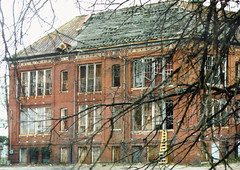Involving the community in school improvement
Since students are outside of school more than they are in school, I am frustrated with lackluster community involvement in the quest for improving our city's schools. I am told that Superintendent Janney is oriented to this, although there is no sight of such now. I wrote in a June blog entry about the success of family learning contracts in some of the poorest areas of Brazil (discussed in a Harvard Business Review article about "positive deviance").
Below is an email from the Asset-Based Community Development listserv, about an schools ABCD-like effort in an area of Boston. Sounds pretty promising, and it is another side of engaging the family, not just the student, into schooling (as opposed to schools).
 While I think the state of the schools physical plant is important, it's really more about the mode and intent of "production" while the students are in class. Lamentably, the hundreds of millions of dollars spent on improving school physical plants in Kansas City, Missouri as part of a broad desegregation order hasn't really lead to greater voluntary integration... Photo of Crummell School by Peter Sefton.
While I think the state of the schools physical plant is important, it's really more about the mode and intent of "production" while the students are in class. Lamentably, the hundreds of millions of dollars spent on improving school physical plants in Kansas City, Missouri as part of a broad desegregation order hasn't really lead to greater voluntary integration... Photo of Crummell School by Peter Sefton.From Marian Knapp--
I am a community improvement consultant who has worked a lot on health and social issues with small groups, mostly in inner city communities.
A few years ago, I was involved in the design and implementation of an assessment of a cluster of schools in the Boston Public School System. It was an independent study, sponsored by a consortium of prominent institutions (medical care, universities, public schools among others), to determine how these institutions could help kids do better in school in this inner city community. I did not use the ABCD model, but developed a framework that captured multiple dimensions related to the goal. These dimensions were:
1. Children: Focus groups with 300 children grades 2 through 12, including older kids who had dropped out of school (some of whom had been in jail and were returning to get a high school diploma. Purpose of the focus groups was to learn
a. what doing well in school meant to them,
b. what helped them do well in school, and
c. what got in the way of doing well in school.
Their responses were categorized and as you would imagine their responses were very enlightening.
2. Parents, guardians, etc.: Focus groups or interviews with parents asking questions similar to those we asked the children, only focusing on what helped them or got in the way of helping their children.
3. Teachers: Similar to parents.
4. School Administrators: Interviews with 12 school principals - similar questions, only more emphasis on the school as a whole and the larger school system.
5. Inventory: Identified all current programs and other resources in each school, as well as what was available in the nearby community.
6. Demogaphics: Primarily to identify different "first" languages spoken by children and families to determine how well schools were addressing language needs. Also looked at distribution of what neighborhoods the kids were coming from to look at whether services were available in their "home" neighborhoods.
7. Analysis and recommendations: Children, parent, teacher and administrator responses were compared for similarities and differences. The inventory was compared to the categories created from the focus groups and interviews to determine how well current programs matched what study participants said. Recommendations were developed for each school.
I have continued to work in several of the schools, including one where I facilitate a parent group, which has recently completed a parent survey to determine areas for improvement. The results of this survey informed the development of and are included in the schools "whole school improvement plan". I am happy to give you more information if you would find it useful.



0 Comments:
Post a Comment
<< Home